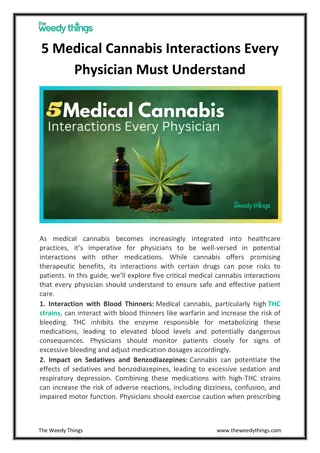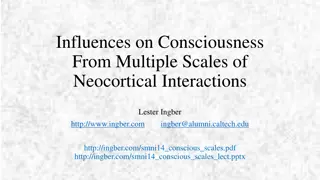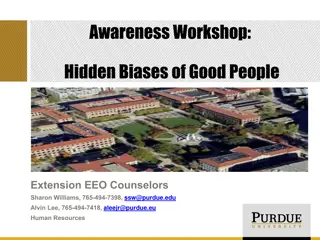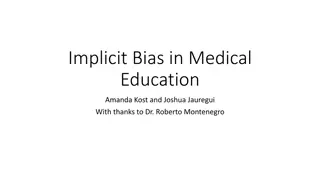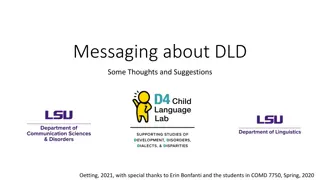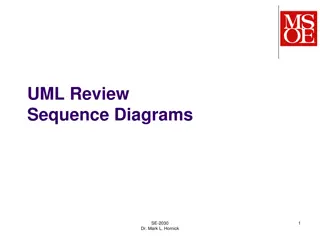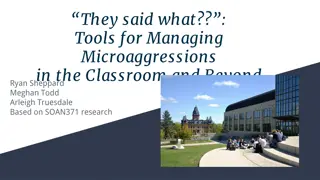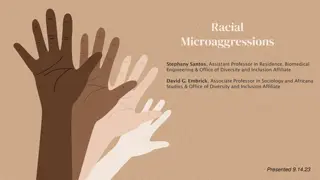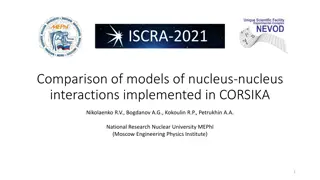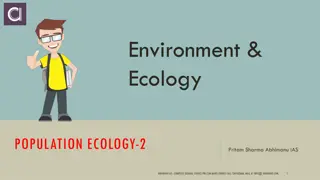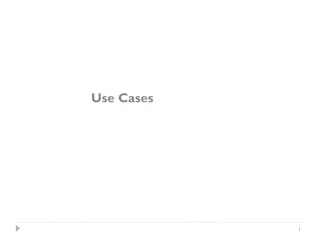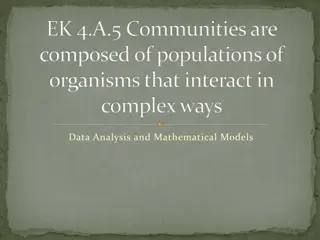Understanding Microaggressions in Everyday Interactions
Unpacking the concept of microaggressions through the lens of Yolanda Flores Niemann's keynote slides, we delve into the manifestations, types, and impacts of these subtle yet harmful behaviors. From verbal and nonverbal acts to environmental displays, microassaults are explored as deliberate actions aimed at conveying negative stereotypes. Recognizing and intervening in microaggressions is crucial for creating inclusive environments in classrooms and beyond.
Download Presentation

Please find below an Image/Link to download the presentation.
The content on the website is provided AS IS for your information and personal use only. It may not be sold, licensed, or shared on other websites without obtaining consent from the author. Download presentation by click this link. If you encounter any issues during the download, it is possible that the publisher has removed the file from their server.
E N D
Presentation Transcript
The Everyday Bullying of Microaggressions: Recognizing and Intervening Yolanda Flores Niemann, Ph.D. University of North Texas Adapted from Renee Wells (SPSSI, 2016) Yolanda Flores Niemann; Microaggressions Keynote Slides for University at Buffalo, SUNY 1
Microaggressions Manifestations of bias Verbal Behavioral Environmental Yolanda Flores Niemann; Microaggressions Keynote Slides for University at Buffalo, SUNY 2
Microaggressions in the Classroom Film https://youtu.be/ZahtlxW2CIQ youtube link Yolanda Flores Niemann; Microaggressions Keynote Slides for University at Buffalo, SUNY 3
Types of Microaggressions Yolanda Flores Niemann; Microaggressions Keynote Slides for University at Buffalo, SUNY 4
Microassaults A microassault is most commonly thought of as overt discrimination. Microassaults can be verbal, nonverbal, or environmental Verbal microassaults include name-calling / use of epithets (Ex: Use of racial and sexist slurs. Nonverbal microassaults include behavioral discrimination (Ex: Not allowing gay persons to join a group; use of black-face by student organizations. Environmental microassaults include offensive signs, posters, or other visual displays (Ex: Displays that feature women as sex objects, ethnic/racial caricatures with exaggerated features, swastikas Adapted from Nadal et al. 2014, Sue et al. 2009, Sue 2011, and Lopez and Zepeda. Yolanda Flores Niemann; Microaggressions Keynote Slides for University at Buffalo, SUNY 5
Microassaults (continued) Microassaults are conscious and intentional acts by an aggressor that are intended to convey negative ideas about a person or group Microassaults most frequently occur When the conveyer can remain anonymous, e.g., a blog with a pseudonym; When people believe that the person hearing the comment or seeing the action will not be offended because they hold the same beliefs; When persons lose inhibitions, e.g., due to loss of emotional control, alcohol or drug use, or other reasons that keep them from filtering their comments or actions. Information from Sue et al. 2009 and Lopez and Zepeda. Yolanda Flores Niemann; Microaggressions Keynote Slides for University at Buffalo, SUNY 6
Yolanda Flores Niemann; Microaggressions Keynote Slides for University at Buffalo, SUNY 7
Campus Hate Crimes Reported hate crimes increased by 25% from 2015-2016 2016, colleges and universities reported 1250 hate crimes based on race, national origin, ethnicity, religion, sexual orientation, gender, or disability (compared to 970 in previous year). FBI reports 67% spike nationally in hate crimes against Muslims from 2014-2015 Most commonly reported hate crimes in 2016 related to racial bias Gender identity hate crimes increased in 2016 More than 38% of hate crimes reported by colleges involved hate-motivated vandalism and destruction of property, an increase of 95 offenses from 2015 Additional 38% classified as criminal acts of intimidation 16% were acts of physical assault (nearly 50% increase from 2015) UNT reported 0 in 2015, and 1 in 2016 Yolanda Flores Niemann; Microaggressions Keynote Slides for University at Buffalo, SUNY 8
Microinsults A microinsult is a comment or action that communicates insensitivity to or disregard for a person s identity or heritage A coach tells an Asian not to bother trying out for an athletic team, conveying the message that Asians are not good at sports; Microinsults may be subtle snubs that convey a hurtful message, e.g., You re Latina, so you should do the cooking and babysitting (message is that Latinas are mainly good at domestic skills and not other valued skills, e.g., leadership, organization) You re pretty for a black girl (message is that black girls are not typically considered attractive). Microinsults are often based on conscious or unconscious group stereotypes. Perpetrators of microinsults may not always be aware that their comments and behaviors are hurtful. Adapted from Nadal et. al 2014, Alabi 2015, Sue et al. 2009, and Sue 2011. Yolanda Flores Niemann; Microaggressions Keynote Slides for University at Buffalo, SUNY 9
Microinvalidations Comments or actions that ignore or dismiss the thoughts, feelings or experiences of a group member. Yolanda Flores Niemann; Microaggressions Keynote Slides for University at Buffalo, SUNY 10
Microinvalidations A woman who reports sexual harassment is told that boys will be boys and she should get over it or consider the harassment a complement: Faculty members dismiss complaints of racism by faculty or students of color. They are told to quit being so sensitive. (underlying message = your reactions and feelings are unwarranted); Latinx students are asked where they are from or where are you really from? (message is that you don t really belong in your own country). Students of Color are told that the election of President Obama means that racism is a thing of the past/post-racial society (underlying message = your experiences of being treated differently because of your race are invalid; your perception is inaccurate) A woman is told that sexual harassment and assault are the fault of the woman, e.g., because she s attractive, was wearing make up, wearing a low cut blouse or short skirt Perpetrators of microinvalidations may not be aware that their comments/behaviors are hurtful, or they may intentionally be engaged in gaslighting. Adapted from Nadal et. al 2014, Alabi 2015, Sue et al. 2009, and Sue 2011. Yolanda Flores Niemann; Microaggressions Keynote Slides for University at Buffalo, SUNY 11
I am color blind; I dont see skin color. A common and egregious microaggression Yolanda Flores Niemann; Microaggressions Keynote Slides for University at Buffalo, SUNY 12
Identity Microaggressions are in many ways an assault on our identity, which is the essence of our being. Yolanda Flores Niemann; Microaggressions Keynote Slides for University at Buffalo, SUNY 13
Activity Think about a time that someone said something about some aspect of your identity that you felt was intentionally or unintentionally dismissive, insulting, or demeaning. Turn to the person next to you and share the following: What was said to you How it made you feel How you responded to what was said How you felt afterwards Yolanda Flores Niemann; Microaggressions Keynote Slides for University at Buffalo, SUNY 14
Activity - 2 Think about a time that you observed or overheard someone commit a microaggression that you sensed was or could have been offensive or hurtful to others. Turn to the person next to you and share the following: What the microaggression was In what way you felt it was offensive A response strategy you could use in the future if you observed or overheard the same microaggression again Yolanda Flores Niemann; Microaggressions Keynote Slides for University at Buffalo, SUNY 15
Microaggressive Trauma The excessive and continuous exposure to subtle discrimination (both interpersonal and systemic), and the subsequent symptoms that develop or persist as a result. Emotions experienced: anger, sadness, worry, resentment, hopelessness, regret, self-doubt The experience is now considered PTSD Post Traumatic Stress Syndrome Epigenetics research indicates that this trauma can be passed on to future generations through our DNA Yolanda Flores Niemann; Microaggressions Keynote Slides for University at Buffalo, SUNY 16
Stereotypes Activity 3 Pictures in our heads We ALL carry stereotypes and implicit biases IAT Implicit Association Test Yolanda Flores Niemann; Microaggressions Keynote Slides for University at Buffalo, SUNY 17
Activity 3 When did you first know you were: Your sex: Male, female, non binary Your race/ethnicity What were the messages associated with that understanding? Yolanda Flores Niemann; Microaggressions Keynote Slides for University at Buffalo, SUNY 18
Stereotype Threat The fear of proving true the stereotypes about your demographic group. Yolanda Flores Niemann; Microaggressions Keynote Slides for University at Buffalo, SUNY 19
Responding to Microaggressions Yolanda Flores Niemann; Microaggressions Keynote Slides for University at Buffalo, SUNY 20
Processing Possible Responses Attributional Ambiguity Did that just happen? Am I misinterpreting what happened? Was what happened motivated by bias? Denying Experiences I m sure they didn t mean anything by it. We re friends. I know she doesn t think that way. She couldn t have meant that. Impotency of Action It won t do any good to speak up. Saying something won t change the way anyone thinks. It isn t worth the effort. Response Indecision What should I do? How should I respond? How do I convince others that what I experienced was a microaggression? Fear of Consequences If I say something, I might get fired. Others will get upset if I say something. What if my experienced is dismissed? Time-limited Responding Something happened and now the moment has passed before I could respond. I can t or don t want to deal with this right now. Information from Lopez and Zepeda. Yolanda Flores Niemann; Microaggressions Keynote Slides for University at Buffalo, SUNY 21
Strategies for Responding to Microaggressions Paraphrase and Ask for Clarity Make sure what you heard is what they said; ask them to help you understand what they meant. I think what you said was _____________; is that correct? Can you elaborate on what you meant by that? I know you didn t intend this, but when you said ____, I felt ____ because ______. Share Your Own Process and Challenge the Underlying Stereotype It helps others to feel less self-conscious and defensive when you share that you used to think or feel similar things, and it helps them expand their awareness when you offer alternative perspectives. I overheard you make the comment that _______________. I used to think that too, but then I learned _________________. Adapted from Goodman 2011. Yolanda Flores Niemann; Microaggressions Keynote Slides for University at Buffalo, SUNY 22
Strategies for Responding to Microaggressions Separate Intent from Impact and Express your Feelings Let them know you understand that they didn t mean to be offensive, but explain why their comment made you uncomfortable. I know you didn t intend this, but when you said ______________, I felt ________________ because _________________. Adapted from Goodman 2011. Yolanda Flores Niemann; Microaggressions Keynote Slides for University at Buffalo, SUNY 23
Express and Promote Empathy Help perpetrators understand the underlying assumptions and impact of what they said. Challenge them to think about how they would feel if someone made a similar assumption about them (the implication that all Muslims are anti-American is hurtful to me because I was born and raised here; this is my home. How would you react if someone assumed that you hated the U.S. and wanted to harm your fellow citizens? Yolanda Flores Niemann; Microaggressions Keynote Slides for University at Buffalo, SUNY 24
The Effect of Not Responding to Microaggressions Not speaking up may result in: Feelings of shame or guilt; Rumination of what a person may have said; poor use of time and emotional energy Emotional energy used coping with repeated microaggressions; Physical and Psychological toll. Yolanda Flores Niemann; Microaggressions Keynote Slides for University at Buffalo, SUNY 25
Activity - 4 What is the microaggression you most experience from others? Practice one or more of the responses to a microaggression Yolanda Flores Niemann; Microaggressions Keynote Slides for University at Buffalo, SUNY 26
Acknowledge Your Own Microaggressions Can you help me understand what just happened? Thank you for letting me know how my comment made you feel. No one has every brought this to my attention before. If you re willing to talk more about it, I d like to better understand the ways my comment was problematic so I can learn from this and also help educate others. I m sorry that what I said hurt you. That wasn t my intention, but I will be intentional about trying to avoid hurting others in that way in the future. Yolanda Flores Niemann; Microaggressions Keynote Slides for University at Buffalo, SUNY 27
Activity 5 Share a microaggression that you committed Acknowledge your microaggression Yolanda Flores Niemann; Microaggressions Keynote Slides for University at Buffalo, SUNY 28
Takeaways for Educators and Staff Yolanda Flores Niemann; Microaggressions Keynote Slides for University at Buffalo, SUNY 29
Key Points for Educators and Staff Remember that microaggressions, including those that are vicariously experienced, can be traumatizing; educators must respond accordingly Understand the impact of microaggressions on students self-esteem and feeling of belonging Research has shown that self-esteem serves as a protective factor for suicide and other psychological disorders, which is particularly important given the increasing prevalence of suicide among various racial and ethnic minority groups Be intentional about creating spaces for students to engage in conversations about their experiences of microaggressions to decrease their feelings of being isolated or alone Work with students to help them develop coping strategies for when they encounter microaggressions to help lessen the emotional impact of these experiences Provide positive reinforcement to increase students self-worth and bolster their resiliency Adapted from Nadal et al. 2014. Yolanda Flores Niemann; Microaggressions Keynote Slides for University at Buffalo, SUNY 30
Key Points for Educators and Staff Many underrepresented students are less likely to seek support services through Counseling but often find a sense of connection in settings with other underrepresented students, so peer mentoring or multicultural support groups can serve as important resources for students coping with microaggressions Because individuals who commit microaggressions are often unaware that they have done so and of the impact, Educators and staff can host programming/events that incorporate intergroup dialogue as a way to foster social justice attitudes, self-reflection, empathy and understanding Adapted from Houshmand and Spanierman 2014. Yolanda Flores Niemann; Microaggressions Keynote Slides for University at Buffalo, SUNY 31
Activity - 6 Share an activity/program that you will lead/develop to reduce microaggressions in your school. Share an activity/program that you will lead/develop to help heal microaggressions committed against educators and students. Yolanda Flores Niemann; Microaggressions Keynote Slides for University at Buffalo, SUNY 32
Examples of Microaggressions by Demographic Group Yolanda Flores Niemann; Microaggressions Keynote Slides for University at Buffalo, SUNY 33
Microaggressions Against African American Students African American students face microaggressions in many contexts in educational facilities, I their workplaces, where they shop. These microaggressions are often related to stereotypes that they are less intelligent, more aggressive or violent, and/or less hardworking than members of other groups Their advisors often discourage them from taking heavy course loads or from taking challenging classes due to the perception that they won t be able to handle it They are often called on less frequently in classrooms and report feeling ignored by professors Educators have low expectations of them, resulting in harm to their educational development; Their peers are often hesitant to include them in group work, creating the perception that they are seen as less capable or less intelligent Educators, staff, and students maintain assumptions that African American students were admitted on the basis of race or for their ability to play sports African American students also experience microaggressions related to their under-enrollment on many campuses They are often asked to speak on behalf of their entire race The experience of being the only black student in a class increases the sense of isolation and otherness and makes participating in class or on campus intimidating and more difficult They are sometimes stopped on campus late at night (including by police and campus authorities) and asked what they are doing in academic buildings, reinforcing stereotypes that portray black youth as criminals; Persons may report African Americans to police or other authorities for just being in a location where they are perceived to not belong. Adapted from Sol rzano et al. 2000. Yolanda Flores Niemann; Microaggressions Keynote Slides for University at Buffalo, SUNY 34
The Impact of Microaggressions Against African American Students These repeated negative interactions impact African American students in a variety of ways: Feelings of self-doubt Feeling like they have to work harder than other students in order to prove themselves Feeling like they have to be guarded when they meet with advisors or Educators in order to defend themselves against discouragement or low expectations Feeling exhausted by the constant scrutiny their actions and performance receive Some African American students drop classes, change their major, or leave to attend a different university in response to these experiences. A common coping strategy for African American students is to seek out counter-spaces at predominantly white institutions (e.g., black student organizations, multicultural centers, peer study groups organized by students of color, etc.) in order to share their experiences and frustrations, feel validated, feel nurtured, and to have their learning fostered in a supportive environment. Adapted from Sol rzano et al. 2000. Yolanda Flores Niemann; Microaggressions Keynote Slides for University at Buffalo, SUNY 35
Microaggressions Against Native American Students Jones and Galliher (2014) found that 98% of Native American students experience daily microaggressions. Like African American and Latinx students, Native American students are assumed to be less capable and less competent than their White or Asian peers in academic settings. Native American students are also forced to deal with microaggressions that portray of them as primitive, lazy, criminal, and prone to alcoholism. Usurping Native American traditions into other cultural behaviors without understanding the inherent meaning in the traditions or ceremonies. Adapted from Jones and Galliher 2014. Yolanda Flores Niemann; Microaggressions Keynote Slides for University at Buffalo, SUNY 36
The Impact of Microaggressions Against Native American Students As Native American students are increasingly confronted with negative stereotypes and colonizing attitudes and become more aware of injustice and inequity, they may seek to reconnect with or immerse themselves in indigenous culture In a society that pressures Native youth to assimilate to mainstream White values, behaving in a more traditional manner can increase the likelihood that Native American students will experience microaggressions Native American students may experience identity conflict if their identity is strongly rooted within indigenous culture, because: They are part of an ethnic community that has been conquered, which can lead to a cross-generational transmission of historical trauma Their community is often positioned as subordinate to both the majority and other minoritized groups The impact of Native American identity conflict can lead to feelings of inferiority as well as distancing from their indigenous culture (assimilation) or distancing from both indigenous and White cultures (marginalization) Adapted from Jones and Galliher 2014. Yolanda Flores Niemann; Microaggressions Keynote Slides for University at Buffalo, SUNY 37
Microaggressions Against Hispanic/Latinx Students Like African American and Native American students, Hispanic/Latinx students are often perceived as less capable and less intelligent than their peers. Among these microaggressions are the following: Having their accomplishments or qualifications questioned (e.g., admission due to affirmative action); Encountering surprise in others when they are academically successful (e.g., comments indicating surprise that they are college/graduate students, especially if they attend prestigious universities); Being perceived as an exception to their race/ethnicity when they are academically successful; Being talked down to by others (e.g., having others speak slowly to them); Being told that they speak excellent English (when others in the classroom are not given that message (communicates lack of belonging); People speaking very loudly to persons with Spanish accents. Hispanic/Latinx students also experience microaggressions in the form of being treated like second-class citizens: Being ignored in stores or assumptions that they are stealing; Receiving differential treatment (e.g., having sales people refuse to acknowledge them as serious customers in high-end stores). Adapted from Rivera et al. 2010. Yolanda Flores Niemann; Microaggressions Keynote Slides for University at Buffalo, SUNY 38
Microaggressions Against Hispanic/Latinx Students Hispanic/Latinx students also experience microaggressions when others criticize the way they speak: Having others complain that they have an accent; Being called out for speaking in Spanish (e.g., This is America. Learn to speak English. ); Having others correct their pronunciation of words. Hispanic/Latinx students are also frequently made to feel like aliens in their own land: Having others question their U.S. citizenship or assume they were born in another country; Overhearing negative remarks about immigration or immigrants (e.g., Here comes another setback. ); Being assumed to be undocumented; Having others question their ability to speak English. Adapted from Rivera et al. 2010. Yolanda Flores Niemann; Microaggressions Keynote Slides for University at Buffalo, SUNY 39
Microaggressions Against Hispanic/Latinx Students Hispanic/Latinx students are often perceived to be criminals or engaged in criminal activity: Being followed out of stores by security guards and asked to show receipts for purchases; Being questioned by campus police when hanging out in groups (i.e., approached because they are acting suspiciously ); Having other students assume they come from dangerous neighborhoods, use drugs, are violent, and/or are members of gangs. Hispanic/Latinx students also experience microaggressions through the invalidation of their experiences: Being told that other groups have it worse when they complain about discrimination; Having others dismiss their ethnic identity (e.g., You don t look Hispanic ). Adapted from Rivera et al. 2010. Yolanda Flores Niemann; Microaggressions Keynote Slides for University at Buffalo, SUNY 40
Microaggressions Against Hispanic/Latinx Students Hispanic/Latinx students also frequently experience stereotypes/generalizations of their cultures: Liking spicy foods, knowing how to Salsa dance, having illegitimate children, being poor, wanting handouts, etc. Hispanic/Latinx students experience microaggressions through the Pathalogizing of their cultural values: Being mocked for having strong religious beliefs; Having their communication style critiqued (e.g., having a Latin temper or being a loud, angry Chicana ); Placing strong values on family, e.g., familiso. Hispanic/Latinx students also encounter microaggressions through their assumed lack of individuality: Ex: Being assumed to be Mexican; Ex: Being told all Latinos look the same Adapted from Rivera et al. 2010. Yolanda Flores Niemann; Microaggressions Keynote Slides for University at Buffalo, SUNY 41
Microaggressions Against Asian American Students Ascription of Intelligence; Individuals who commit these microaggressions describe the intent of these comments as compliments, but the impact of making assumptions about the intellectual ability of entire ethnic groups can be detrimental to Asian American students: You people always do well in school; If I see lots of Asian students in my class, I know it s going to be a hard class; Feel pressured to conform to stereotypes, even when they don t enjoy subjects like math or science or aren t good at them; Feel trapped when their peers come to them for help with subjects in which they don t excel; Struggle with the tension created when they are chosen for group projects instead of other students of color; Their desire to pursue academic interests outside of math and science are often questioned. Adapted from Sue et al. 2009 and Houshmand and Spanierman 2014. Yolanda Flores Niemann; Microaggressions Keynote Slides for University at Buffalo, SUNY 42
Microaggressions Against Asian American Students Denial of Racial Reality: Because Asian Americans are perceived as model minorities who are successful, the perception is often that they do not experience inequities or acts of bias; Thus, many microaggressions against Asian Americans invalidate their lived experiences of racial discrimination. Invalidation of Interethnic Differences (underlying message is that differences between Asian Americans do not exist or do not matter): Are you Chinese? All Asians look alike Adapted from Sue et al. 2009. Yolanda Flores Niemann; Microaggressions Keynote Slides for University at Buffalo, SUNY 43
Microaggressions Against Asian American Students Pathologizing Cultural Values / Communication Styles; The underlying message is that Asian Americans are expected to assimilate to White/Western cultural practices and communication styles in order to be accepted or to meet expectations Penalizing Asian American students for their lack of participation in class discussions when many of them were raised with traditional cultural upbringings that value silence; Making fun of Asian Americans for traditional cultural clothing or spiritual / religious beliefs / customs; Perpetual Foreignizing; The underlying message is that Asian Americans are not from here, are not real Americans, or do not belong here Where are you from? or Where were you born? You speak English very well Adapted from Sue et al. 2009. Yolanda Flores Niemann; Microaggressions Keynote Slides for University at Buffalo, SUNY 44
Microaggressions Against Asian American Students Invisibility Many Asian Americans experience invisibility and exclusion in spaces where conversations about race / ethnicity take place because their identities and experiences are often not included in what others perceive to belong to people of color; While Asian Americans are often viewed as being like Whites, they often experience bias and a lack of acceptance from White peers. Exoticizing of Asian American Women / Non-Exoticizing of Asian American Men Western stereotypes of Asian women portray them as passive, subservient, exotic sex objects devoted to the gratification of men; Asian American women are often approached by White men who express a desire for a Geisha to fulfill their Asian fetish Asian American men are often portrayed within Western culture as lacking sexual agency or as impotent. Adapted from Sue et al. 2009. Yolanda Flores Niemann; Microaggressions Keynote Slides for University at Buffalo, SUNY 45
Microaggressions Against White Students Ascriptions about political ideology You must have voted for Trump Assumptions about white women Jokes about blond women with message of unintelligence Assumptions of being daddy s girl and having it made Assumptions that white women only care about fashion (not critical thinkers) Assumptions of Wealth Assumptions that white students don t need financial aid and/or don t have to worry about money Assumptions of Being Racist Are members of your family in the KKK? Aare you a Neo-Nazi? We know you re afraid of Black people Yolanda Flores Niemann; Microaggressions Keynote Slides for University at Buffalo, SUNY 46
Microaggressions Against International Students Ostracized for studying too hard and performing too well academically Experience hostility from their peers for creating competitive academic environments Assumption that an accent equals lack of intelligence Research shows that perceptions associated with international students accents stem from discomfort and unwillingness to accommodate difference rather than difficulties related to communication International students who seek help on campus with English proficiency often encounter impatience from those whose job it is to help them International students also experience microaggressions when other students mock or attempt to mimic their accents Adapted from Houshmand and Spanierman 2014. Yolanda Flores Niemann; Microaggressions Keynote Slides for University at Buffalo, SUNY 47
Microaggressions Against International Students Excluded and Avoided; These experiences of cultural exclusion and intolerance impact international students sense of belonging and adjustment to both campus and culture, which is particularly isolating for students who are far from their homes, families, and other support systems. International students often feel excluded from the social interactions of their peers who reference American cultural knowledge (e.g., television shows), tell jokes, or use slang; International students often do not have the cultural knowledge or experience to engage in or understand these conversations, and their peers often make no effort to try to include them or help them understand; Some international students report overt microassaults, such as being told to go home; While international students express a desire for meaningful interactions with their peers, they often describe feeling rejected. Adapted from Houshmand and Spanierman 2014. Yolanda Flores Niemann; Microaggressions Keynote Slides for University at Buffalo, SUNY 48
Microaggressions Against Muslim Students Endorsing Religious Stereotypes Portrayed as anti-American and as terrorists Racial profiling related to terrorism Pathologizing Religious Practices Perception that their religious traditions or practices are oppressive, abnormal, or sinful Muslim women encounter microaggressions frequently for wearing their hijabs Ex: Muslims report being told that they are worshipping the wrong God or that their beliefs are wrong Adapted from Nadal et al. 2012. Yolanda Flores Niemann; Microaggressions Keynote Slides for University at Buffalo, SUNY 49
Microaggressions Against Muslim Students Assumption of Religious Homogeneity Assumptions that all persons in a context are Christian or believe in God Ridicule for wearing head coverings Adapted from Nadal et al. 2012. Yolanda Flores Niemann; Microaggressions Keynote Slides for University at Buffalo, SUNY 50





